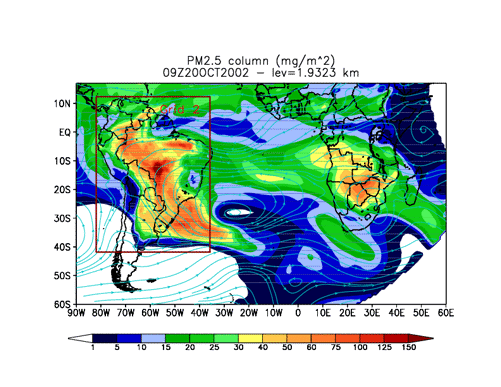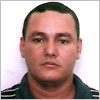The Group Modeling of the Atmosphere and its Interfaces (GMAI) carries
out studies and generates products related to the atmosphere and its
interaction with the other components of the earth system. The adopted
methodology includes the development of numerical models that are run on
high performance computer systems and state-of-the-art parameterizations of
physical and biogeochemical processes, the treatment and analysis of direct
and remote sensing observations, and the assimilation of these data into the
numerical models.
From the numerical modeling point of view, GMAI has been developing and
improving a number of models and parameterizations for studies related
to numerical weather and climate forecasting, air quality and chemical
composition of the atmosphere, and soil water storage. Various GMAI models
are used operationally at CPTEC/INPE, and other developments have been
implemented in US models (CAMx, GEOS-5, WRF-CHEM and FIM-CHEM).
In particular, GMAI leads the development of the CCATT-BRAMS (Coupled Chemistry-Aerosol-Tracer Transport model to BRAMS) model that
simulates emissions, transport, chemical reactivity and deposition of gases
and aerosols in the atmosphere. CCATT-BRAMS is used on an operational
basis by CPTEC/INPE for air quality forecasting over South America as well
as for various studies of social and scientific interest.
GMAI maintains a complete meteorological and air quality monitoring station
and will also acquire observational data for studies with and validation of
numerical models. GMAI has access to two high performance clusters for its
numerical studies, the most recent of which includes 200 AMD/OPTERON
processor cores linked by an InfiniBand network.
Since 1999, GMAI members have published nearly 70 articles in scientific
journals and 140 works in conference proceedings. In addition to the scientific
contribution, the groupÕs operational focus offers support to public health,
economic, and social actions and policies related to the short and medium
term impacts of atmospheric pollutant emissions and transport.

Copyright ©INPE/CPTEC 1995 - 2007 - Comments and / or suggestions:
Contact us | FAQ (Frequently Asked Questions)




 Name: Karla Maria Longo
Name: Karla Maria Longo Name: Saulo Ribeiro de Freitas
Name: Saulo Ribeiro de Freitas Name: Ariane Frassoni dos Santos
Name: Ariane Frassoni dos Santos Name: Claudio Augusto Borges Pavani
Name: Claudio Augusto Borges Pavani Name: Demerval Soares Moreira
Name: Demerval Soares Moreira Name: Fernanda Batista Silva
Name: Fernanda Batista Silva Name: Fernando Cavalcante dos Santos
Name: Fernando Cavalcante dos Santos Name: Julliana Larise Mendonça Freire
Name: Julliana Larise Mendonça Freire Name: Luiz Flávio Rodrigues
Name: Luiz Flávio Rodrigues Name: Madeleine Sánchez Gácita
Name: Madeleine Sánchez Gácita Name: Marcos Cezar Yoshida
Name: Marcos Cezar Yoshida Name: Rafael Mello da Fonseca
Name: Rafael Mello da Fonseca Name: Rafael Stockler Santos Lima
Name: Rafael Stockler Santos Lima Name: Ricardo Almeida de Siqueira
Name: Ricardo Almeida de Siqueira  Name: Rodrigo de Oliveira Braz
Name: Rodrigo de Oliveira Braz Name:Valter José Ferreira de Oliveira
Name:Valter José Ferreira de Oliveira Name: Ana Graciela Ulke
Name: Ana Graciela Ulke  Name: Cláudio Moisés Santos e Silva
Name: Cláudio Moisés Santos e Silva Name: Daniela de Azeredo França
Name: Daniela de Azeredo França Name: Gabriel Pereira
Name: Gabriel Pereira Name: Marcelo Felix Alonso
Name: Marcelo Felix Alonso Name: Megan Marie Bela
Name: Megan Marie Bela Name: Nilton M. Évora do Rosário
Name: Nilton M. Évora do Rosário